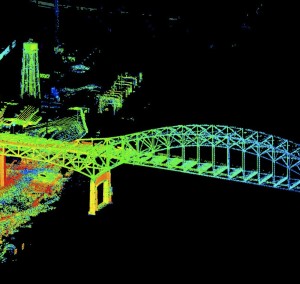Budget clouds 3-D mapping of entire U.S.
Even in flusher times, the idea of hiring Cessna crews to bounce laser light off every square meter of the United States over the course of eight years sounded like a hard sell.
Lidar, or light detection and ranging, has been used in the U.S. for about 15 years as an urban modeling and terrain mapping tool. Lidar visualizations can help determine the best place to position surveillance cameras or snipers in a homeland security crisis. They can help FEMA predict flooding before hurricanes. On the highways, terrain data could even make cruise control more fuel efficient by giving advance notice of uphills and downhills.
Two years ago, when U.S. officials began laying the ground work to take that smattering of lidar data nationwide, they were probably braced for the standard questions about health (the light is safe, they say) and privacy:
“You can see the shape of my swimming pool; the slope of my roof,” said one fan of the technology. “Sooner or later, someone’s going to say, ‘I don’t know how I feel about that.’”
This year, the task has fallen to the U.S. Geological Survey to push the proposed 3-D Elevation Program forward in Congress against even bigger forces: sequestration cuts and the further reductions lawmakers are eyeing for the USGS parent agency, the Interior Department. That's quite a climate to start a major new initiative.
“Some people would say it’s impossible – but I would say ‘not easy’ is a better characterization,” said Larry Sugarbaker, senior adviser for USGS’s National Geospatial Program, which would include 3DEP.
Here's USGS's argument: Although sequestration doesn’t allow new starts, 3DEP isn’t exactly one of those. Lots of lidar data is already collected on behalf of individual states, NOAA, FEMA, the National Geospatial-Intelligence Agency and the Department of Homeland Security. The data is a hodgepodge, covering only about 30 percent of the country. It’s accumulated as the state and federal agencies tackle their unique missions: NOAA does coastal surveying; DHS and NGA map urban areas in three dimensions. No one does very much elsewhere.
The White House wants USGS to organize and expand collections into a country-wide National Lidar Dataset that would be refreshed every eight years. All told, USGS and the other agencies would need to spend about a billion dollars -- $146 million annually – to get it done. Today, the U.S. spends about $50 million a year on lidar.
Some call the new approach multi-agency funding. Others call it passing the hat. Either way, “We count on NGA and others to contribute” and “to increase their collections,” Sugarbaker said.
The 3DEP cost estimate comes from a March 2012 study called the “National Enhanced Elevation Assessment." It was drafted by the engineering company Dewberry under contract to USGS. Dewberry estimates that mapping all of the U.S. in 3D would generate “benefits” valued at anywhere from $1.2 billion to $13 billion a year. The study doesn’t explain the huge range. Most advocates have seized on the higher figure. It includes estimated decreases in property losses and a 25 percent reduction in the costs of collections through higher volume.
Sugarbaker conceded that Dewberry, which performs surveying and mapping work, would be a beneficiary of 3DEP, but he said working with the company made sense because of its expertise. The conflict of interest was dealt with by giving Dewberry very specific marching orders to provide information – not judgments – about a range of alternatives.
USGS decided on the second best lidar data, called “Quality Level 2.” Two pulses of laser light will bounce off each square meter of the surface, instead of eight times under Level 1.
For its part, USGS wants $23.7 million in 2014, an $11 million increase. Most of the increase would be spent on data acquisition by the private sector. Two additional federal positions would be added to bring the team to 59.
According to a draft USGS implementation plan, a solicitation would be released in June 2014 followed by the first contract awards in November to those who would fly the planes and process the raw data. Those will be called Geospatial Products and Services contracts.
The 3DEP proposal has lots of industry backers, not surprisingly. The initiative would be a welcome “strategic approach,” said John Pallatiello, executive director of MAPPS, the Management Association for Private Photogrammetric Surveyors in Reston, Va.
The U.S. has been collecting lidar over about 2 to 3 percent of the country a year, according to the Dewberry report, meaning it would take 35 years to map the whole country.
Sugerbaker said the rate has climbed to about 5 percent more recently, but that the basic point still holds. It will take a government initiative to map the whole country and keep the data fresh.
“We do the best job we can to stitch it together. The result of that is about a third of the country is done. But that data is aging. North Carolina is about 11 or 12 years old,” he said.
One Comment
Trackbacks/Pingbacks
- United States National LiDAR Collection Underfunded | Weather in the City - [...] about 30% of the United States has been scanned by aerial LiDAR systems according to a article from Deep…




You don’t need to use LIDAR for the vast bulk of this project – that is old technology and simply not necessary for the vast tracts of open terrain involved. Instead, USGS should be embracing photogrametric technologies that produce high-resolution models from 2D imagery.